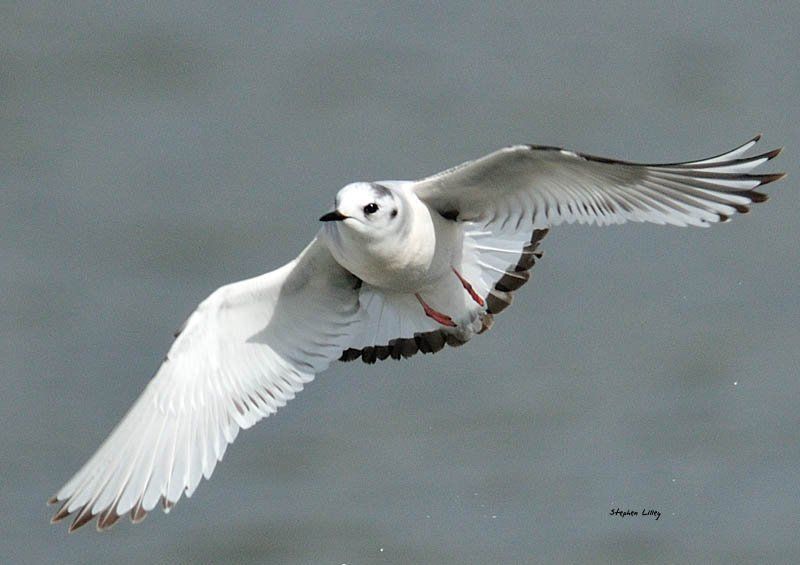GREAT SKUA Stercorarius skua
Scarce passage visitor
1992
A dark brown bird with prominent white patches on the upper wing flew up the Calder Valley towards Elland on the afternoon of 11th October.
LONG-TAILED SKUA Stercorarius longicaudus
Scarce passage visitor
1999
A bird was sen flying north-west at Dob Park Wood in the Washburn Valley on 28th April.
ARCTIC SKUA Stercorarius parasiticus
Scarce passage visitor
1991
There was a record of two flying west at Fly Flatts Reservoir on 29th August.
1994
A dark phase bird flew south-west over Fly Flatts Reservoir during the evening of 25th August. This was followed by a single again flying south over Fly Flatts Reservoir in the evening of the next day.
2004
An adult pale-morph bird flew north-west past Barden watchpoint in the afternoon of 12th July. This is only the fourth Group record, and the first since 1994.
2006
After only three records up to 1994, there have now been two in just over 24 months. The Group’s fifth record was represented by a pale-phase bird which gave good views as it flew west over Kex Gill on 9th September
2012
A bird seen from Oxenhope watchpoint on 28th August becomes only the sixth Group record, and the first since 2006.
2013
A bird flew directly over the head of an experienced birder at Yeadon Tarn on the afternoon of 28th September and it was identified as a juvenile, in its dark morph phase. This species has now been recorded in consecutive years and this was the seventh Group record. On the 20th October, a bird believed to be a Skua species was watched from Oxenhope watchpoint as it traversed the Aire Valley.
2015
A bird initially seen very close was watched from the Oxenhope Watchpoint as if flew north westwards into the Worth Valley on 25th September. The was the ninth Group record.
MEDITERRANEAN GULL Larus melanocephalus
Uncommon but regular winter and passage visitor.
Seen regularly since 1989. Most recent sightings:
2013 - The excellent run, which commenced in 2010, continued with 17 reports of 13 different birds, mostly from Airedale. The locations were as follows:
Redcar Tarn: Adult birds were recorded here on 4th January and 28th March. On 26th July, a bird which was seen on a number of occasions, was last reported on the 5th August on Highfield Road Playing Fields . A small bird, presumably a female, was present here on the 9th December.
Cullingworth Fields: Whilst there was a bird at Redcar Tarn, a different adult was located amongst Black-headed Gulls on 30th July. In the following month (24th), a juvenile, moulting into 1st-winter plumage, was noted and on 28th November another adult was found.
Barden: A bird was heard calling at the upper reservoir on 20th April.
Bolton Abbey: A bird seen displaying to a Black-headed Gull was watched on 12th May.
Thornton Moor Reservoir: An adult bird on 4th August.
Lindley Wood Reservoir: A juvenile bird was seen on the evening of 28th August and another bird a month later.
Leeshaw Reservoir: The final sighting was a 2nd-winter bird which flew off to the north-west on 26th December.
2014 - There were six reports, all from the same observer, involving single birds at three sites. An adult bird was identified at Swinsty Reservoir on 22nd January and three more adults were seen in the south of the area in October: at Thornton Moor Reservoir on 17th and 24th and at Leeshaw Reservoir on the 28th. Two further Thorton Moor records comprised a 2nd-winter bird on 3rd November and a 1st-winter on the 14th.
2015 -
Just four records and, as last year they were all from the same observer. Two adult birds were seen on 26th May at Redcar Tarn and a juvenile was at Lower Laithe Reservoir on 23rd July. The other two records involved single adults, both at Cullingworth Fields, in November and December.
2016
- After the past two years, when numbers recorded were in single figures, 2016 produced 10 birds, more in line with the totals for the three years prior to 2014. Unusually, all but two of them were sub-adults. Six locations were involved:
Redcar Tarn: An adult was seen on 10th February and on 21st August there was a juvenile, which remained until 6th September.
Leeshaw Reservoir: The year’s other adult flew west on 19th May.
Thornton Moor Reservoir:
Juveniles were present on 20th July and 18th August, with a 2nd-summer three days later.
Cullingworth Fields:
Two juveniles on 19th August.
Lower Laithe Reservoir:
In the same productive period, a juvenile/1st-winter was seen on 30th August.
Brown Royd (Bradford):
A 1st-winter in a pre-roost gathering of Black-headed Gulls, carried a red Darvic ring, indicating East European origin. It was present on 12th and 13th October.
2017
- After several years of many sightings, there was, inexplicably, just one record: a 2nd-winter bird at Cullingworth on 15th January.
2018
- Though an improvement on 2017, the unexplained reduction in sightings continues. Redcar Tarn provided records of a 2nd-winter bird on 22nd February, followed by adults on 29th June and 12th July. In August, a juvenile was at Brown Royd on 3rd, and a single at Scargill Reservoir on the 27th.
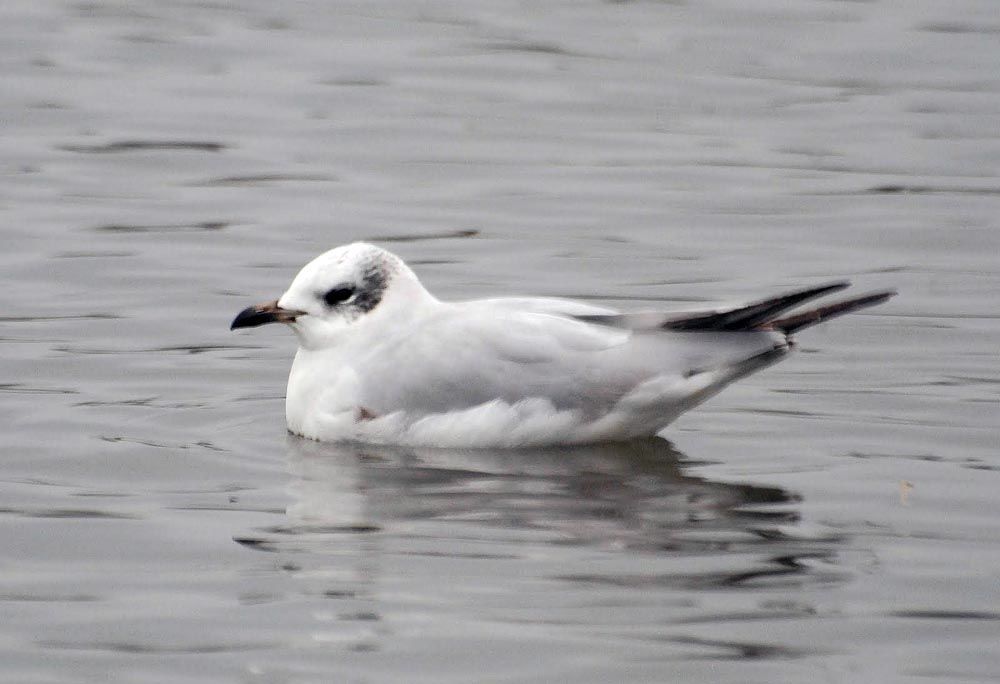
Mediterranean Gull (above) at Redcar Tarn in January 2010.
An adult Mediterranean Gull with a Black-headed Gull at Redcar Tarn in March 2010. photos: Keith Moir

Little Gull at Redcar Tarn on 10th April 2012.
photo: Stephen Lilley
LITTLE GULL Larus minutus
Scarce passage visitor
Most recent sightings:
2002
A first-summer bird provided close views at Yeadon Tarn on 23rd May.
2003
A lone second summer frequented Elland Gravel Pits on 21st April.
2004
The only record concerned an adult bird at Yeadon Tarn on 9th May.
2005
The two records of this attractive gull both came from the south of the Group area. A 1st-summer bird was seen at Elland Gravel Pits on 5th April. The other record, a 1st-year bird, was on the less typical date of 7th November, when it arrived at Leeshaw Reservoir with Black-headed Gulls, before quickly departing.
2009
A 2nd-winter bird was at Thornton Moor Reservoir on 10th November.
2010
Recorded for the second successive year, and again from Thornton Moor, where two birds spent 10 minutes on 30th July.
2012 An obliging 1st-winter bird spent the morning at Redcar Tarn on 10th April.
2013
For the second consecutive year, there was a record of this attractive Gull. A bird was seen near Yeadon Tarn on 23rd June as it swooped down into a field. The observer reported that there may have been a second bird which clearly showed a black head and black bill.
2014
This small attractive gull was reported for the third consecutive year. A bird, first seen on 20th April at Yeadon Tarn, stayed for a further day before departing northwards in late afternoon.
SABINE'S GULL Larus sabini
Vagrant
1987
Undoubtedly the bird of the year was discovered at Chelker Reservoir on 20th October, being seen by many members, before departing on 23rd. A victim of gale force winds, this bird was the most northerly representative of a wreck of Sabine’s lifted from the Bay of Biscay. Superficially a winter plumaged adult, the absence of a red orbital ring would seem to indicate that it was second summer bird.
RING-BILLED GULL Larus delawarensis
Vagrant
1991
A second-winter bird paid a brief visit to Low Moor Tip, Bradford, on 27th December.
1992
A first-winter bird was present at Low Moor Tip on 3rd December.
YELLOW-LEGGED GULL Larus cachinnans Increasingly common and regular passage migrant.
Seen each year since 1992 when it was split from Larus argentatus.
2015 -
It was a very similar picture to 2014, with 18 birds seen at seven locations; all except one bird were reported by the same observer. Seven of the gulls appeared at Redcar Tarn between May and November, these all being non-breeding birds in various stages of development - two juveniles, three 1st-winter, a 1st-summer and a 2nd-summer bird.
At Leeshaw Reservoir, what was thought to be the returning bird of 2014 (now in 2nd-summer plumage) was seen intermittently from spring to early autumn, and briefly also visited nearby Lower Laithe Reservoir. A 1st-winter bird appeared during the last week in August, and a different 2nd-summer was here in early October, also being seen at Thornton Moor Reservoir. The latter site also hosted one of the year’s few adults, in April, and a 3rd-summer bird in late June. In Bradford, a 1st-winter, was at Girlington for three days in October, and a juvenile at nearby Brown Royd on 11th August. Finally, four different adults were in the flocks at Cullingworth Fields during late August and early September.
2016
- Following its being given full specific status, rather than a sub-species of Herring Gull, records started to appear in 1992, and have increased ever since, to the point where, with this year’s tally, the gull can almost be regarded as common in the area. That said, all the reports came from south of the River Aire, and are attributable to just five observers. Almost all the sightings relate to the period between late June and early September when birds accompany the many Lesser Black-backed Gulls passing through the area, and there were only three records outside this, a 1st-winter bird at Redcar Tarn on 31st January, and adults at Cullingworth on 6th March and 31st December.
Thornton Moor Reservoir remains the main and most intensively watched site, and nearly 60% of the records came from there. Given the transient nature of all the gulls in the main period, it is impossible to say with any accuracy how many different birds were involved, but it is probable there were at least 43. In July, all the birds were adults, but by August (when most birds seen were recorded) there were also sightings of at least four juveniles, a 1st-winter, a 2nd-winter, and 10 3rd-summer birds. The largest single count was of six birds on 11th August. Redcar Tarn had two 2nd-winters in July, and two juveniles in August, Brown Royd a 1st-summer in June and three different 1st-winters in August and September, and a sub-adult, possibly one of the Thornton Moor contingent, was seen at Ogden in September.
At Leeshaw Reservoir, the bird first seen in 2014, and now in 3rd-summer plumage, returned for its third successive year. It paid a brief visit to nearby Lower Laithe Reservoir, but was otherwise faithful to the site between 9th July and 21st August.
2017
- The exponential increase continues, probably largely due to increased observer awareness and regular coverage of the transient Lesser Black-backed parties, which are often the carrier species. About 74 birds were recorded, all from the south, and from five main areas:
Cullingworth Fields 8 adults 18 sub-adults
Redcar Tarn - 13 sub adults
Thornton Moor Reservoir 4 adults 6 sub-adults
Leeshaw/Lower Laithe/Leeming 3 adults 13 sub-adults
Brown Royd, Bradford - 9 sub-adults
At Leeshaw Reservoir, the returning bird, now in 4th-summer plumage, was present for its fourth year.
2018
- Though numbers are well down on last year, 45 different birds is still a significant total. The main sites are the same as 2017:
Cullingworth Fields 1 adult 2 sub-adults
Redcar Tarn - 2 adults 10 sub adults
Thornton Moor Reservoir 1 adult 6 sub-adults
Leeshaw/Lower Laithe/Leeming 3 adults 6 sub-adults
Brown Royd, Bradford - 1 adult 8 sub-adults
Single adults were also seen near Barden, and at Queensbury, and Ogden Reservoir, and two sub-adults were at Scargill.
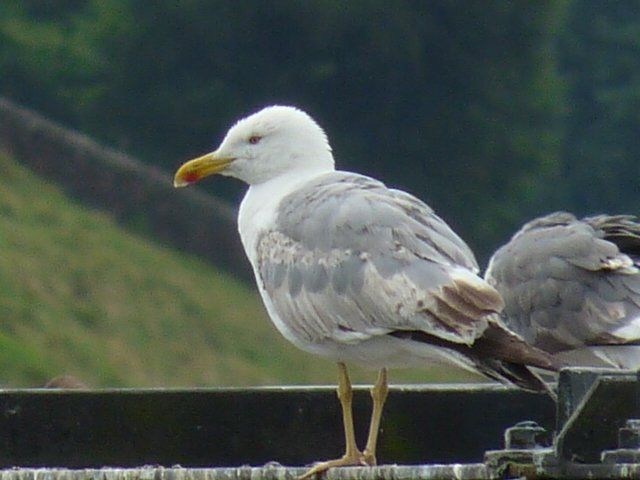
A Yellow-legged Gull at Lower Laithe Reservoir, 24th July 2016.
Photo: Keith Moir

A juvenile Glaucous Gull at Cullingworth, January 2008. Photo by Brian Vickers
GLAUCOUS GULL Larus hyperborcus
Scarce winter visitor
Most recent sightings:
1996
All sightings occurred at Sugden End Tip or in the adjacent fields near Flappit Spring. A first-winter bird was seen there on 4th January, and in February on 11th, 17th and 18th. Also present during this period was a third-winter bird, which seen on 11th and 18th February. A hybrid second-year gull, thought to be Glaucous x Herring was present in the roost at Thornton Moor Reservoir on 7th January.
1997
An adult bird roosted on the ice at Thornton Moor Reservoir on 11th January, a first-winter individual roosted at the same site on 25th January and again the following evening. What was probably the same bird was seen at Manywells Height on 27th January, and again in the roost at Thornton Moor Reservoir the next day. There were no more sightings until 31st December, when a very large first-winter individual was present for just one evening in the Thornton Moor Reservoir roost before moving on.
2000
First-winter birds were seen at either end of the year. The Flappit Spring area of Cullingworth had the first, on 10th, 11th, 14th and 15th January, and on 24th December, one was present in the Swinsty Reservoir roost.
2001
Only one record: a first-winter bird seen at Silsden Reservoir on 9th February.
2008
A juvenile at Cullingworth from 8th to 10th January, was the first since 2000.
2018
- A 1st-winter bird at Brown Royd on 25th March was the first record for 10 years.
ICELAND GULL Larus glaucoides
Scarce winter visitor
A species seen most years from 1987 to 2001 on open land fill sites.
1996
A good year, with all recorded sightings occurring at Sugden End Tip or in the adjacent fields near Flappit Spring. A first-winter bird was present there on 10th, 11th, 14th and 18th February; a third-winter bird was seen on 16th February. In March, another (or possibly the same) first-winter individual was seen on 8th, 9th and 30th.
1997
A first-winter bird was seen at Sugden End Tip on 5th January. A second-winter individual, first seen on the same site on 20th January, was also recorded on several occasions at Thornton Moor Reservoir and Manywells Height on subsequent days. On 31st Jnauary a different second-winter bird was present in the roost at Thornton Moor Reservoir. First-winter individuals were recorded on eight dates between 1st and 15th February at Thornton Moor Reservoir, Manywells Height and Sugden End Tip.
1999
There was one recorded at Otley Gravel Pits on 3rd January.
2000
This was the best year since 1997, with two, and possibly three, birds recorded, the first of which was a first-winter bird seen briefly at Mannywells Tip on 4th March. In the second winter period there was a string of sightings during December, possibly involving the same adult bird, first seen in the Swinsty Reservoir roost on 23rd. This, or another, adult bird was at the Thornton Moor Reservoir roost from 26th to 31st, having been also seen with other gulls on Hewenden Reservoir on 28th. A record of another bird, at Cullingworth, was not accompanied by the necessary description.
2001
Just one record was received: a first-winter bird in fields near Ben Rhydding on 24th March.
2011
A welcome return of a bird not seen since 2001, a juvenile was at Cullingworth on 13th January.
2017
- This gull has now become very scarce in the area, so two records, both of 2nd-winter birds, is a bonus. A bird at Cullingworth Fields on 25th February stayed only briefly, but the other remained, intermittently, at Redcar Tarn from 5th to 10th March.
CASPIAN GULL Larus cachinnans Scarce migrant/possible winter visitor.
2014 -
The Group’s first records concerned three, and possibly four, different birds. A juvenile was found at Redcar Tarn on 31st July, and another, a juvenile moulting into 1st-winter plumage, was there on 12th August. The same location had an identifiably different 1st-winter bird on 5th September, and what may have been the same one was observed briefly at nearby Cullingworth Fields the following day.
All the birds were photographed (see below), and the records have been accepted by the Yorkshire Naturalists’ Union.
2016 -
Following the Group’s first records in 2014, another three, possibly four, birds were found this year. A 1st-winter at Redcar Tarn on 2nd, 4th and 7th February was thought to be the same bird seen there in 1st - summer plumage on 31st May. Different individuals were a 2nd-summer bird at Brown Royd (Bradford) on 8th August, and a 2nd-winter at Thornton Moor Reservoir on 7th September, the latter being the Group’s eighth record.
2017
- The running total for this scarce gull becomes 12, following juveniles at Brown Royd on 29th July and 15 October, a 1st-winter photographed at Warley Moor Reservoir on 16th October, and a 2nd-winter at Redcar Tarn six days later. This bird had been ringed in Germany in June 2016, and had been seen a month later near Penistone.
2018 - Five records is now about the norm. Brown Royd had 1st calendar-year birds on 2nd and 13th/14th October, 2nd calendar-year birds were on Redcar Tarn on 7th March and Cullingworth Fields on 17th September, and the first Washburn record was another 1st calendar-year at Scargill Reservoir on 6th August. As the species is now breeding further west, there is increasing hybridisation with Herring Gulls, and three birds were seen which showed these characteristics.
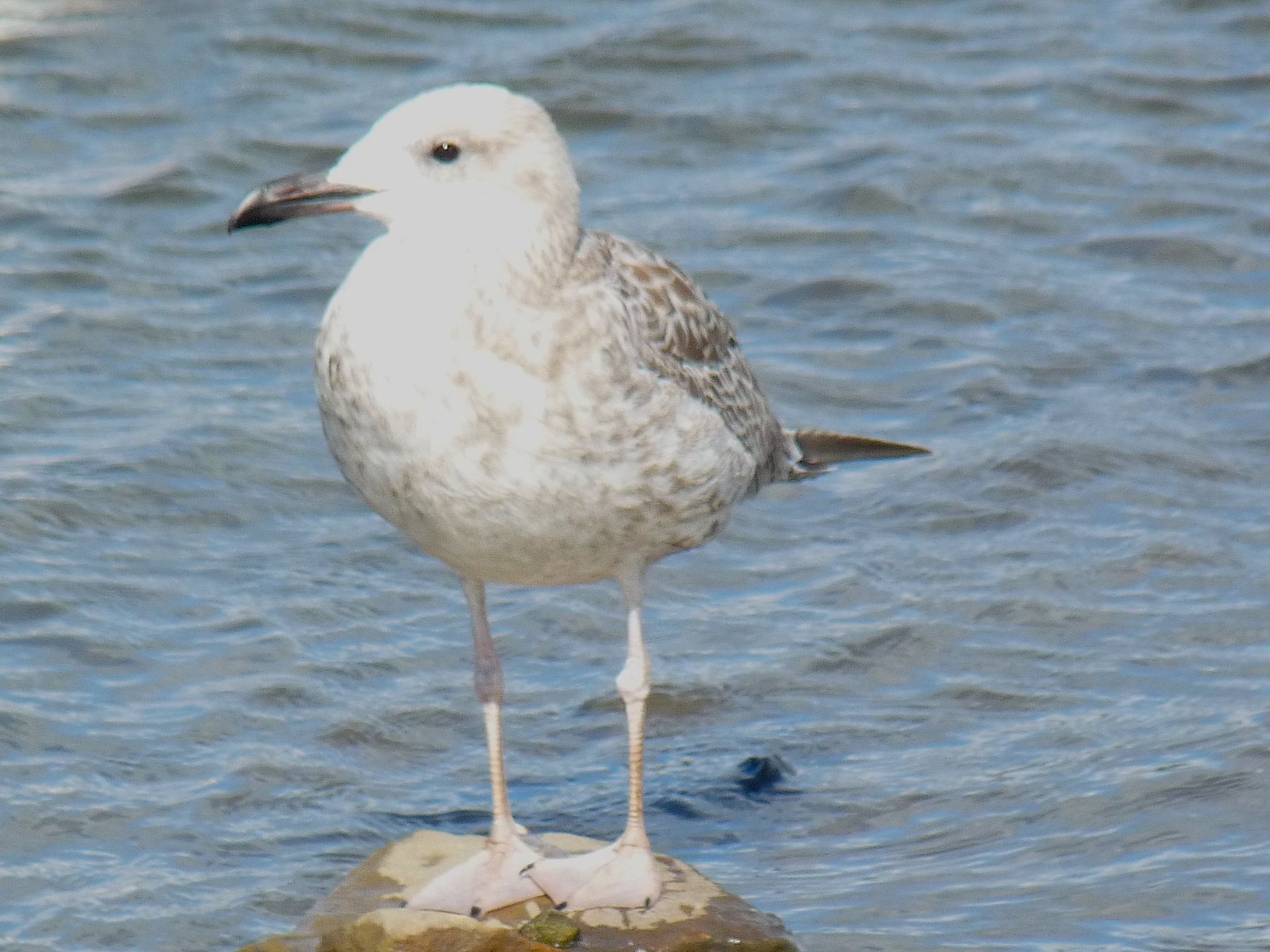
Caspian Gull at Redcar Tarn photos: Keith Moir
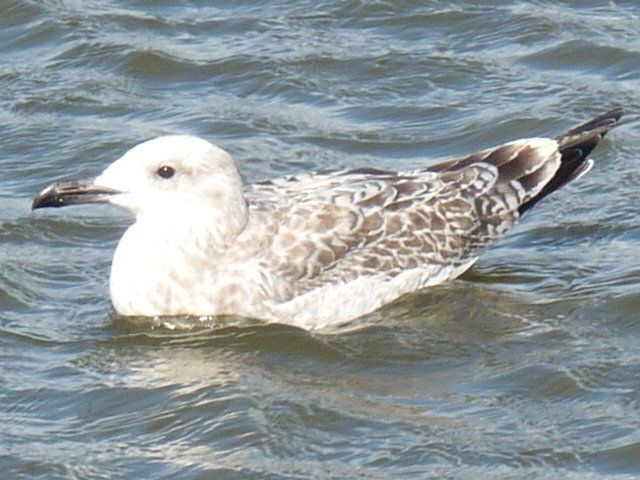
KITTIWAKE Rissa tridactyla Uncommon passage/winter visitor
Seen most years from 1987 to 2002. Most recent sightings:
2003 -
Just two records both of single adults, the first of which was at Elland Gravel Pits on 2nd March (HBC) and the second was flying north at Kex Gill on 22nd March.
2004 -
One was found at Knotford Nook on 13th March, with another at Elland Gravel Pits on 10th April. In autumn, a bird was seen heading east from Denholme Clough during a visible migration watch on 12th September.
2005 -
Three records are about the norm. All came from the south of the recording area, and were of a bird at Elland Gravel Pits on 15th April, three birds at Thornton Moor Reservoir on 14th May, and one at Ogden Water on 4th August.
2008 -
Two records of this distinctly erratic visitor: a bird at Redcar Tarn on 29th March, and another at Warley Moor Reservoir on 3rd May.
2009 -
Recorded for the second successive year, a bird was seen at Thornton Moor on 11th October.
2010 -
Recorded for the third year in a row, a juvenile was briefly at Redcar Tarn on 28th August.
2015 -
Three birds this year, the first records since 2010. On 10th May, the first one was seen in the Riddlesden area and then on the 18th an immature bird bathed in Warley Moor Reservoir before continuing its journey northwards. During a heavy rain shower, the final bird dropped onto Leeshaw Reservoir with several Black-headed Gulls on 20th November. Once the conditions improved it flew away to the west.
2016 -
Recorded for the second successive year, after nothing since 2010. On 14th February, two birds were seen, one at Otley Wetland, and the other in the Thornton Moor roost. The second winter period then had two at Leeshaw Reservoir on 21st November.
2017
- Singles were at Warley Moor Reservoir on 17th March, and near Queensbury on 11th September.
2018
- A corpse was discovered at Warley Moor on 22nd March, but, happily, a live bird was there the following day.

